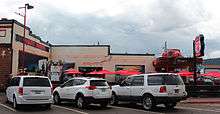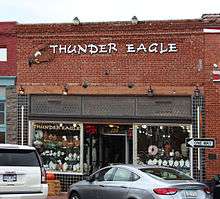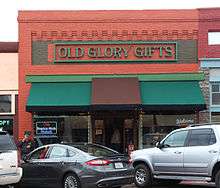Urban Route 66, Williams
|
Urban Route 66, Williams | |
 | |
  | |
| Location | Bill Williams Ave. between Sixth St. and Pine St., Williams, Arizona |
|---|---|
| Coordinates | 35°14′56″N 112°11′31″W / 35.24889°N 112.19194°WCoordinates: 35°14′56″N 112°11′31″W / 35.24889°N 112.19194°W |
| Area | 3.2 acres (1.3 ha) |
| MPS | Historic US Route 66 in Arizona MPS |
| NRHP Reference # | 89000376[1] |
| Added to NRHP | May 19, 1989 |

U.S. Route 66 through Williams began as a dirt street in the center of town which was later cindered and then paved. Despite some modern encroachments, most of U.S. Route 66 through Williams is lined with properties dating from the historic period. The four block long Williams Historic Business District was listed on the National Register of Historic Places on December 20, 1984.[1]

It is flanked on the east and west by a commercial strip with motels, service stations, and restaurants dating to the 1920s, 1930s, and 1940s. One block of this commercial strip is west of the business district, and four blocks are to the east. The distribution and construction dates of these associated properties in Williams are directly related to construction of U.S. Route 66.[1]
Unlike many stretches of U.S. Route 66 today, it is a good example of what the highway "looked like" during its heyday.[1]
Williams continues to cater to the tourist trade, although Interstate 40 bypassed Route 66 on October 13, 1984.[1]
| Name | Year Built | Architectural Style | Comments |
Rock Building
 Rock Building, 326 W. Route 66, Williams, AZ |
1936[2] | ||
Babbitt-Polson Building
 Babbitt-Polson Building, 314 W. Route 66, Williams, AZ |
1907 | Only Art Deco style building in Historic District[1] | Originally five smaller buildings combined and covered with stucco; housed grocery, hardware, department stores and bakery[2] |
Bennett's Auto
 Bennett's Auto, 239 W. Route 66, Williams, AZ |
1930's | Modern Style | Gas station during heyday of Route 66 when gas sold for $0.16/gallon[2] |
The Postal Telegraph Co.
 The Postal Telegraph Co., 239 W. Route 66, Williams, AZ |
1910 | Operated until 1940's | |
Unknown named original building
 Unknown Building, 229 Route 66, Williams, AZ |
ca. 1910[2] | ||
Rittenhouse Haberdashery
 Rittenhouse Haberdashery, 225 W. Route 66, Williams, AZ |
ca. 1910 | Was a men's clothing store for 60+ years[2] | |
Grand Canyon Drug Company
 Grand Canyon Drug Company, 221 W. Route 66, Williams, AZ |
ca. 1912 | Pharmacy and soda fountain in front, doctor's office in rear[2] | |
Old Parlor Pool Hall
 Old Parlor Pool Hall, 217 W. Route 66, Williams, AZ |
ca. 1910[2] | ||
Lebsch Confectiionery
 Lebesch Confectionery, 213 W. Route 66, Williams, AZ |
ca. 1914[2] | ||
Dime Store
 Dime Store, 209 W. Route 66, Williams, AZ |
ca. 1912[2] | ||
Duffy Brother's Grocery
 Duffy Brother's Grocery Store, 201 W. Route 66, Williams, AZ |
1912 | Originally a bank, mostly grocery store, also a dime store. Original tin ceiling[2] | |
Citizens Bank
 Citizen Bank, 202 W. Route 66, Williams, AZ |
1918 | Neoclassical revival | Financial center of lumber, ranching, and railroad operations; closed in 1958[2] |
Sultana Theatre
 Sultana Theatre, 301 W. Route 66, Williams, AZ |
1912 | Saloon, billiard hall, silent movie theatre; liquor and gambling during prohibition; first "talkie" in Northern Arizona shown in 1930[2] | |
Pollock Building
 Pollock Building, 104 N. 3rd Street, Williams, AZ |
First floor constructed after 1901 fire; 2nd floor 1927 | "Rusticated" Romanesque Revival | Originally bank, has been newspaper, telephone/telegraph office. Constructed of locally quarried dacite; 2nd story brick[1][2] |
Grand Canyon Hotel
 Grand Canyon Hotel, 145 W. Route 66, Williams, AZ |
1892 | Victorian Commercial style | Has survived several fires; the ground floor has served as a drug store, grocery store, dance hall, curio shop, and a meeting hall for Knights of Pythias Lodge[2] |
Unknown originally named building
 Unknown Named Building, 135 W. Route 66, Williams, AZ |
1907[2] | ||
Old Post Office
 Old Post Office, 132 W. Route 66, Williams, AZ |
ca 1907 | ||
General Store
 General Store, 129 W. Route 66, Williams, AZ |
1907[2] | ||
Adams Grocery
 Adams Grocery, 125 W. Route 66, Williams, AZ |
ca. 1907[2] | ||
Bowden Building
 Bowden Building, 114 W. Route 66, Williams, AZ |
1947 | Flagstones quarried from "Flagstone Capital of the World", 18 miles west of Williams; built during the post-WWII migration to California[2] |